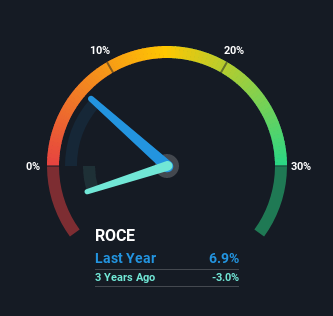- United States
- /
- Tech Hardware
- /
- OTCPK:DBDQ.Q
We Like These Underlying Return On Capital Trends At Diebold Nixdorf (NYSE:DBD)
There are a few key trends to look for if we want to identify the next multi-bagger. Ideally, a business will show two trends; firstly a growing return on capital employed (ROCE) and secondly, an increasing amount of capital employed. Put simply, these types of businesses are compounding machines, meaning they are continually reinvesting their earnings at ever-higher rates of return. Speaking of which, we noticed some great changes in Diebold Nixdorf's (NYSE:DBD) returns on capital, so let's have a look.
Return On Capital Employed (ROCE): What is it?
If you haven't worked with ROCE before, it measures the 'return' (pre-tax profit) a company generates from capital employed in its business. The formula for this calculation on Diebold Nixdorf is:
Return on Capital Employed = Earnings Before Interest and Tax (EBIT) ÷ (Total Assets - Current Liabilities)
0.069 = US$140m ÷ (US$3.6b - US$1.6b) (Based on the trailing twelve months to September 2021).
Thus, Diebold Nixdorf has an ROCE of 6.9%. Ultimately, that's a low return and it under-performs the Tech industry average of 9.1%.
Check out our latest analysis for Diebold Nixdorf

In the above chart we have measured Diebold Nixdorf's prior ROCE against its prior performance, but the future is arguably more important. If you're interested, you can view the analysts predictions in our free report on analyst forecasts for the company.
What Can We Tell From Diebold Nixdorf's ROCE Trend?
You'd find it hard not to be impressed with the ROCE trend at Diebold Nixdorf. The figures show that over the last five years, returns on capital have grown by 65%. The company is now earning US$0.07 per dollar of capital employed. Speaking of capital employed, the company is actually utilizing 44% less than it was five years ago, which can be indicative of a business that's improving its efficiency. Diebold Nixdorf may be selling some assets so it's worth investigating if the business has plans for future investments to increase returns further still.
On a separate but related note, it's important to know that Diebold Nixdorf has a current liabilities to total assets ratio of 43%, which we'd consider pretty high. This effectively means that suppliers (or short-term creditors) are funding a large portion of the business, so just be aware that this can introduce some elements of risk. While it's not necessarily a bad thing, it can be beneficial if this ratio is lower.
The Bottom Line On Diebold Nixdorf's ROCE
In a nutshell, we're pleased to see that Diebold Nixdorf has been able to generate higher returns from less capital. Astute investors may have an opportunity here because the stock has declined 62% in the last five years. So researching this company further and determining whether or not these trends will continue seems justified.
If you want to continue researching Diebold Nixdorf, you might be interested to know about the 1 warning sign that our analysis has discovered.
For those who like to invest in solid companies, check out this free list of companies with solid balance sheets and high returns on equity.
Mobile Infrastructure for Defense and Disaster
The next wave in robotics isn't humanoid. Its fully autonomous towers delivering 5G, ISR, and radar in under 30 minutes, anywhere.
Get the investor briefing before the next round of contracts
Sponsored On Behalf of CiTechNew: Manage All Your Stock Portfolios in One Place
We've created the ultimate portfolio companion for stock investors, and it's free.
• Connect an unlimited number of Portfolios and see your total in one currency
• Be alerted to new Warning Signs or Risks via email or mobile
• Track the Fair Value of your stocks
Have feedback on this article? Concerned about the content? Get in touch with us directly. Alternatively, email editorial-team (at) simplywallst.com.
This article by Simply Wall St is general in nature. We provide commentary based on historical data and analyst forecasts only using an unbiased methodology and our articles are not intended to be financial advice. It does not constitute a recommendation to buy or sell any stock, and does not take account of your objectives, or your financial situation. We aim to bring you long-term focused analysis driven by fundamental data. Note that our analysis may not factor in the latest price-sensitive company announcements or qualitative material. Simply Wall St has no position in any stocks mentioned.
About OTCPK:DBDQ.Q
Diebold Nixdorf
Engages in the automating, digitizing, and transforming the way people bank and shop worldwide.
Undervalued with worrying balance sheet.
Similar Companies
Market Insights
Weekly Picks

THE KINGDOM OF BROWN GOODS: WHY MGPI IS BEING CRUSHED BY INVENTORY & PRIMED FOR RESURRECTION


Why Vertical Aerospace (NYSE: EVTL) is Worth Possibly Over 13x its Current Price


The Quiet Giant That Became AI’s Power Grid
Recently Updated Narratives


MINISO's fair value is projected at 26.69 with an anticipated PE ratio shift of 20x


Fiverr International will transform the freelance industry with AI-powered growth

Jackson Financial Stock: When Insurance Math Meets a Shifting Claims Landscape
Popular Narratives


MicroVision will explode future revenue by 380.37% with a vision towards success


Crazy Undervalued 42 Baggers Silver Play (Active & Running Mine)





